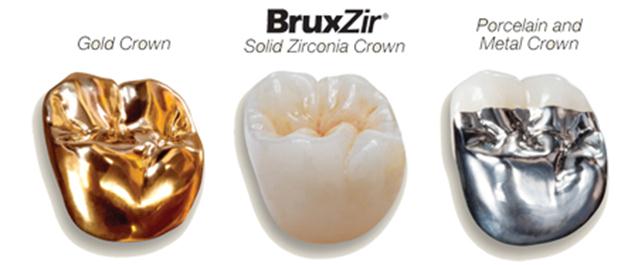The part of a natural tooth above the gum line, covered with enamel, is called the 'crown' of the tooth. Simply, it is the part of the tooth that is visible when you smile. Sometimes the enamel becomes discolored, decayed, or misshapen. This can be removed by dental work and replaced with a new covering, called crown. In Dentistry, a crown is a type of dental restoration that fully covers part of the natural tooth lying above the gum line.
Why Teeth Need crowns?
This type of teeth needs restoration with crowns:
- Teeth having a history of root canals
- Teeth consisting of more than half of filling material
- Teeth that have circumferential gingival decay i.e. the decay is spreading at the gum line
- Teeth that appear ugly due to wear, discoloration etc.
- For fractured teeth.
Composition of Dental Crowns:
A dental crown used as a restorative is usually made of porcelain, metal like gold, metal alloy, or a combination of these. To give extra strength to the crown, it is made of porcelain covering an internal metal coping.
The Following types of crowns are most commonly used:
- Gold Crowns
- Porcelain Crowns
- Porcelain Fused-to-Metal Crowns
Gold Crowns:
Gold crowns are relatively easy to prepare and do not cause wear on opposing teeth. They also provide a healthier environment for the gum tissue. The main disadvantage of gold crowns is that their color does not match that of natural teeth and hence is not preferred for front teeth restoration.
Porcelain / Ceramic crowns:
The main reason porcelain crowns are preferred is that they look as natural as one's own teeth. When compare to the other restorations the possibility of staining is very minimal for Porcelain crowns.
Porcelain Fused-to-Metal Crowns:
These crowns too have a very natural look. However, they fail to replicate the translucency of natural teeth because of having a metal substructure. Sometimes, a dark line is visible at the edge of the crown, near the gum line.
Other Types of Crowns:
Beside the three main types of crowns, other types are also used as temporary restorations, these include:
Polycarbonate Crowns: used for restoring front teeth
Stainless steel Crowns: used for restoring back teeth
Dental Bridges
Dental Bridges are widely accepted and cost effective cosmetic restorations which hold the teeth together.
Dental bridges are named so because they bridge the gap in the mouth between successive teeth when one or more teeth are lost.
Nature of a Dental Bridges:
A bridge consists of two crowns for the teeth, one on either side of the gap. These anchoring teeth are known as abutment teeth and there is a false tooth or teeth (called pontics) placed in between. The false teeth vary in composition from gold, different alloys, porcelain, or a combination of these. Both natural teeth and implants support bridges.
Benefits of Dental Bridges:
The single most important benefit of a bridge is the ability to replace a missing tooth or teeth in minimal time as a fixed option in the mouth.
Other Benefits of dental bridges include:
- Restoring the ability to chew and speak better
- Restoring your smile
- Maintaining proper facial shape
- Properly distributing the forces during eating
- Keeping teeth from drifting out of their natural position
Types of Dental Bridges:
Presently, three main types of dental bridges are available
- Traditional Bridges
- Cantilever Bridges
- Maryland Bonded Bridges
Traditional Bridges
These are the most common type of dental bridges, involving a crown for the tooth or implant on both sides of the missing tooth with a pontic between them. Traditional bridges are made of porcelain or ceramics.
Abutments - The teeth that support the missing tooth in the bridge.
Pontic - Replacement for the missing tooth.
Beside the three main types of crowns, other types are also used as temporary restorations, these include:
Cantilever Bridges
These bridges are used in areas where less biting forces are present. Depending on number of teeth we are replacing the teeth on only one side of the missing teeth will be used as abutments.
Maryland Bonded Bridges
These are also known as resin-bonded bridges .These type of bridges are composed of plastic teeth and gums with a metal framework supporting them. Metal wings on both sides of the bridge are bonded to the adjacent natural teeth on both sides of the missing tooth.
Implant Supported Bridge
Dental Bridge can also be supported with dental implants.
Process for making a Dental Bridge
The following steps are followed in obtaining a dental bridges:
-
The dentist prepares the abutments (adjacent natural teeth) during the first visit.
-
Impressions are taken to simulate the preparation for lab.
-
A temporary bridge is made for you to wear for the protection of your exposed teeth and gums.
-
The temporary bridge is removed in the following visit and the permanent bridge is fitted.
-
More visits may or may not be required for adjusting the bridge.
Lifetime of Dental Bridges
The lifetime of dental bridges vary, lasting five to seven years or sometimes longer. If the patient maintains good oral hygiene and takes effective preventive measures, the bridge can last for more than ten years.
Eating with a Dental Bridge
It is generally easier to eat with a dental bridge. Take soft food, cut into small pieces, until you become accustomed to the dental bridge.
Speaking with a Dental Bridge
Having a dental bridge brings the anterior teeth in a proper relationship and makes speaking easier than that with missing teeth.
Care for Dental Bridge:
Follow the general hygiene habits:
- Brushing teeth twice a day, keeping the underneath surface of the pontic clean with special cleaning aids such a Water Pick and Proxy Brush.
- Flossing daily
- Keeping up with cleaning appointments in dental office.
- Eat balanced diet

